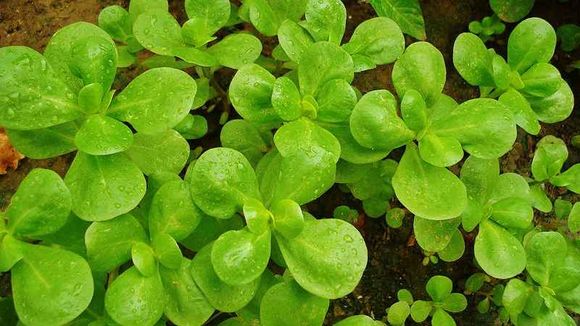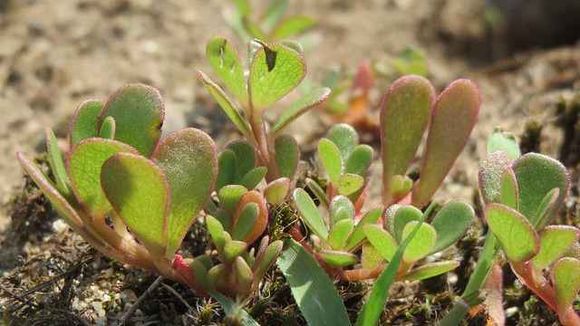What is Purslane (Portulaca Oleracea)
Portulaca oleracea is a one-year-old plant that belongs to the eponymous family of Portulacaceae [ [ref. 1] ] This juicy plant contains about 93% water. There are red stems and small green leaves. Its taste is slightly sour or salty, similar to spinach and watercress, but very fresh. In culinary it can be used as spinach and lettuce, for example in salads or sandwiches.
The purslane grows in many parts of the world, in a wide range of environments. It can grow in gardens and cracks on the sidewalks, but it can also adapt to harsh conditions. This includes drought, as well as very salty or nutrient-poor soil.
An interesting fact about the purslane is that it is high in many nutrients and is a source of alkaloids with anti-inflammatory action. In addition to antioxidants and omega fatty acids with cardioprotective action, a portion of 100 grams contains the following nutrients: [ [ref. 2] ]
- Vitamin A (from beta-carotene): 26% of daily values
- Vitamin C: 35% of daily values
- Magnesium: 17% of daily values
- Manganese: 15% of daily values
- Potassium: 14% of daily values
- Iron: 11% of daily values
- Calcium: 7% of daily values
You get all these nutrients for just 16 calories! This positioned the purslane as one of the best nutrient-rich foods on the planet, as is the blue-green algae spirulina. [ [ref. 3] ]
Key benefits of the Purslane (Portulaca Oleracea)

Purslane is high in omega-3 fatty acids
Omega-3 fatty acids are important fats that the body cannot produce, so we need to get them from the diet. While the purslane is low in total fat, much of the fat it contains is omega-3 fatty acids.
In fact, the plant contains two types of omega-3 fatty acids, ALA (alpha-linolenic acid) and EPA (eicosapentaenoic acid). ALA is found in many plants, but EPA is mostly found in animal products (such as oily fish) and algae. Compared to other plants, the purslane is extremely rich in ALA. Contains 5-7 times more alpha-linolenic acid than spinach. [ [ref. 4] ]
Portulaca Oleracea is rich in antioxidants
The purslane is rich in various antioxidants and beneficial plant compounds, for example:
- Vitamin C: Also known as ascorbic acid, vitamin C is an antioxidant that is essential for maintaining skin, muscles and bones, as well as immune protection.
- Vitamin E: Contains high levels of a form of vitamin E called alpha-tocopherol. It can protect cell membranes from oxidative damage.
- Vitamin A: Contains beta-carotene - an antioxidant that the body converts into vitamin A. Vitamin A is best known for its role in eye health and vision.
- Glutathione: This important antioxidant can protect cells from damage and is one of the strongest antioxidants in the human body.
- Melatonin: The tunic also contains melatonin - a hormone that can help you fall asleep and enjoy good brain function. [ [ref. 5] ]
- Betalain: It synthesizes betalains, antioxidants that have been shown to protect low-density lipoprotein (LDL) particles from damage. [ [ref. 6] ]
The purslane has a high content of important minerals
Purslane is also high in several important minerals. The plant is a good source of potassium - a mineral that helps regulate blood pressure as well as calcium, the most common mineral in the body that is key to bone and tooth health. Phosphorus and iron are also found in lower amounts in the purslane.
Portulaca Oleracea also contains oxalates
On the other hand, purslane also contains large amounts of oxalates. This can be a problem for people who tend to develop kidney stones, since oxalates can contribute to their formation. [ [ref. 8] ] It is important to clarify that oxalates also have antinutrient properties, which means they can interfere with the absorption of minerals such as calcium and magnesium. [ [ref. 9] ]
Recipe for salad with purslane
Ingredients:
- 1/4 cup red onion, thinly sliced
- 1 lemon, drained
- 1 tablespoon red wine vinegar
- 1 tie, chopped and removed thick stems
- 2 tablespoons olive oil
- 2 tablespoons plain full-fat yogurt
- A pinch of salt
- Pinch of pepper
- 1/2 cup feta cheese
- 1/2 cucumber, chopped
- 3/4 cup melon, diced
- 5 radishes, thinly sliced
Instructions for preparation:
- In a small bowl combine red onion, red wine vinegar and lemon juice. Set aside marinate for at least five minutes.
- Put the purslane in a large bowl and drizzle it with olive oil and yogurt. Using a pinch, spread the olive oil and yogurt evenly over the greens. Add salt, pepper and lemon zest and stir. Add the red onion, vinegar and lemon juice, stir again and add the remaining ingredients.








